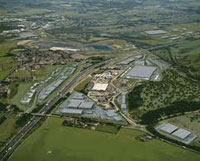Is Brexit’s bark worse than its bite? With careful asset selection, the UK regions could be an even a better bet for investors than they were before the vote to leave the EU
You have seen it a thousand times: “Keep calm and carry on”. Printed on countless tea towels, mugs and T-shirts, this cosy Second World War slogan has become a British motto, and since the 23 June vote to leave the European Union it has also become a piece of property industry wisdom.
 Investors pulled £483m out of UK property funds in July as they digested the referendum result, according to data from Morningstar. But talk to landlords, investors, developers or intermediaries in the UK’s big regional cities and you hear the same message from everyone.
Investors pulled £483m out of UK property funds in July as they digested the referendum result, according to data from Morningstar. But talk to landlords, investors, developers or intermediaries in the UK’s big regional cities and you hear the same message from everyone.
“It’s OK,” they say, scarcely able to believe it themselves. “No, it’s really OK.”
And for the time being it is, mostly. The sky did not fall in on 24 June, despite the temporary liquidity issues faced by the retail funds.
So now the panic has turned to plodding, how do investors navigate a path through the Brexit property scene? Those responsible for making the English regions as appealing as possible believe they have the answer.
Jonathan Browning is a former managing director at Jaguar, the iconic British car maker, and also a former chairman of Vauxhall. Today he is leading the Coventry & Warwickshire Local Enterprise Partnership, charged with persuading investors that his part of the Midlands is still in business, despite the Brexit vote.
“Yes, uncertainty can have an impact on investment plans and commitments, but we have to show our international partners they can have faith and trust in us,” he says.
“This is a globally significant area for the automotive sector. We have 1,500 auto companies in Coventry and Warwickshire alone, along with the big names like Jaguar Land Rover, BMW and Aston Martin. It is a powerful working economy and we do not plan to let that reputation slip, whatever happens in the Brexit negotiations.”
Browning promises “maximum assurance” to investors, but the best possible assurance is proof that regional property economies are strong and likely to stay strong. Fortunately, the evidence is there to support this.
Browning’s backyard is expected to see another 200 acres of land progressed for automotive developments before the year is out, with land supply dwindling. Rents are rising to £6.75 per sq ft for industrial/logistics floorspace, and land prices are peaking at £600,000 an acre – and none of those healthy numbers are likely to change suddenly, except to go up.

For these reasons many observers point to warehousing, logistics floor space and industrial premises as the top defensive buy in post-referendum Britain.
A similar logic suggests the UK’s main regional office markets are also good defensive buys. Unlike London – where serious fears about the financial services sector raise questions over long-term demand – the regional cities have limited supply, stable or growing demand, and a good story to tell.
Even so, the Brexit vote slowed the regional office markets. Bilfinger GVA’s analysis of the big nine regional cities suggests take-up slipped by about 3% in the second quarter of 2016, but rents were unaffected. Net effective rents were up by 4.9% on the year, it says, with incentives down (rent-free periods falling from 22 months to 20 months, on average).
Regional investment volumes have hardly moved since the EU vote. Overseas interest in the regional office market is up – accounting for 47% of volumes, compared with 29% last year, says Savills – with German investors at the fore.
German bank Deka was undeterred by the Brexit vote when it bought a Manchester office block for £164m, crowning a busy half-year. The city is already ahead of its 2015 total office investment, up to £353m from £331m last year, say Savills.
Bristol and Edinburgh are also significantly up on last year (54% and 87% respectively). These are not cities suffering an international crisis of confidence.
The retail sector presents a more complicated story. Some say it is largely out-of-play, but a minority disagree. In 2014 the Crown Estate paid £346m for Leicester’s Fosse Park in a joint venture with China’s Gingko Tree Investments – and have not touched regional retail since.
Hannah Milne, director of regional portfolio at the Crown Estate, explains: “Across the UK, capital markets have been slowing since late last year, which we see as more down to the late stage of the capital market cycle than the vote for Brexit.
“This is why we have not bought a substantial standing asset since Fosse Park two years ago, but continue to believe that while investors should be exercising caution in the retail sector, prime assets, dominant in the catchment, will continue to deliver strong returns.”
The UK regions are not without their problems – and not every regional asset, or every region, offers a strong post-Brexit investment angle. But with careful selection, the UK regions are as good a bet – perhaps even a better bet – than they were before 23 June.

The Manchester exception
There has been one constant rule in the property business over the past 20 years: whatever you say about the UK’s regional cities, Manchester is the exception.
Although Birmingham and Leeds dispute the data, and the other seven of the top 10 regional cities hotly resent its success, Manchester has built up tremendous political and economic momentum. The city’s super-sized devolution deal – it goes far beyond that offered to other cities, including London, to include prisons and the health service – is proof. The devolved administration takes over in May 2017 under a directly elected regional mayor.
Yields reflect the city’s wide investor appeal: prime city office yields are 4.75% (or less), keener than the 5%-5.25% common in rivals such as Birmingham and Leeds.
So is Manchester an exception to the post-Brexit vote property prognosis? The government’s Northern Powerhouse initiative – which yokes northern cities to form a £300bn economy – has given the city a timely boost. Foreign investors, especially from Germany, are taking a close interest, despite the Brexit vote.
In August, German bank Deka paid £164m for Argent/GMPV’s new 280,000 sq ft office block at One St Peter’s Square, Manchester. The move came soon after German investor Hansainvest bought Amazon’s 280,000 sq ft distribution hub at Airport City Manchester from Mountpark for close to £35m.
In a release issued to the German financial markets, Deka said: “After London, Greater Manchester is the most important economic area in the UK and the largest regional office market.”
James Porteous, capital markets director at JLL, says: “The amount of German money looking to buy into Manchester runs into many hundreds of millions of pounds. They want to buy the best, and Manchester is the best – the problem is there is only so much good office or warehouse property around to buy in the city at any one time. That slows things down. Some are prepared to sit on their hands and wait – others spot other opportunities in places like Edinburgh or Frankfurt, and buy there instead.”
Panic over?
Around £18bn was frozen in UK retail funds in July after several major asset managers called a temporary halt to withdrawals.
The funds – including Columbia Threadneedle, Henderson, M&G, Aviva and Standard Life – acted to protect liquidity after investors withdrew £1.4bn in June, about 6% of the total.
But within a fortnight several funds eased the prohibition, including Aberdeen Asset Management.
 Northshoring set to thrive
Northshoring set to thrive
Performance in the UK’s regional office markets has been underpinned by the prospect of jobs relocated from hyper-expensive London.
So-called “northshoring” – cutting labour and property costs by moving jobs from the capital to the northern cities – is expected to survive, and perhaps thrive, in the new Brexit Britain.
“The UK regional office markets are a defensive buy, more so than London,” says Savills research director Mat Oakley. “They are already attractive to occupiers because of their lower occupational costs and wage costs, and they might become even more appealing if instability in the UK economy encourages London-based businesses to cut costs by moving to the regions.”
The mathematics of northshoring can get very complicated, but at its most basic assume the median cost of a London-based office worker is £35,000 per year in pay, plus employment taxes, and another £15,000 a year to provide them with a desk. In the strongest regional markets the figures would be £25,000 and £6,000 respectively.
Oakley says: “It is almost impossible to imagine any fall in London salaries or office costs, short of a total economic meltdown, that could alter the balance to make northshoring less attractive.”
Add to this the relative shortage of new regional office space – across the regions about one-third of the space under construction is prelet – and it looks like a resilient market. Data from Knight Frank suggests that the regions are the place to be, although it is important to pick your region with care.
The first half of 2016 saw a total of 16.2m sq ft transacted in units of more that 50,000 sq ft. The figure is 14% down compared with the second half of 2015, and 4% down on the same period last year.
The firm reports a downturn in enquiry levels has been seen in some locations, something which was being witnessed across the sector prior to the EU referendum and is not thought to be a direct result of the UK’s Brexit vote.
But London and the South East saw take-up fall by 30%, while Manchester and the North West took a similar tumble (down by 37% compared with last year). The Midlands’ “golden triangle” enjoyed a sharp increase, up by around 30%.

Time to step up industrial investment
Tritax Big Box REIT is one of a long list of UK and overseas investors to decide that now is the time to step up investment in UK sheds.
Of course, there is a clue in the name – Big Box – but its decision to fund the development of a £56.3m logistics facility in Wolverhampton is regarded as significant.
The 52-acre site, developed by Bericote, is proof that a strong occupational market underpins the investment scene. Gestamp, a German auto components business, has prelet 544,000 sq ft at the scheme close to junction 12 of the M6 motorway. It has an option to take another 101,000 sq ft.
A German occupier on a 25-year lease, subject to five-yearly reviews indexed to RPI inflation, gives the deal a golden appeal for investors.
And there is plenty more where Gestamp came from. A short drive north in the East Midlands takes you to the 225,000 sq ft warehouse now being built for German car parts business Ferdinand Bilstein. It signed up for the unit at Henry Boot and Derbyshire County Council’s 200-acre Markham Vale North in April. The company reviewed the decision after the EU referendum and decided to press ahead.
Richard Meering, who heads CBRE’s Midlands logistics and industrial agency team, says: “The Midlands is the Mayfair of sheds. It is home to the country’s biggest warehousing units and the epicentre of its distribution network. This is reflected in the record levels of take-up we have seen so far this year and the consistent levels of commitment to the region.
“To put this year’s market into perspective, total take-up in the region for 2015 was circa 7m sq ft, so this has been a very healthy start to the year.”
Among the deals contributing to the 5.6m sq ft total take-up in the Midlands were Jaguar Land Rover’s commitment to a further 468,955 sq ft across two units at Prologis Park in Ryton, Coventry, and Boden’s preletting of 275,220 sq ft at Wilson Bowden’s Optimus Point in Leicester.
The East Midlands accounted for 23% of total UK take-up – the highest in the country, with the West Midlands taking second place with 19%.

Office tech apocalypse cancelled
Fears that European cities such as Berlin and Dublin could snatch London’s tech business are beginning to seem far-fetched. But there are signs that the UK regions could be about to lure some of the capital’s tech, media and digital business, as the appeal of northshoring grows among mid-size tech businesses.
According to Nesta, the government body charged with promoting digital Britain, the largest digital clusters outside London are in the Thames Valley (£10bn turnover), Bristol and Bath (£8.2bn), Manchester (£2.2bn) and Birmingham (£1.8bn).
Andre James, head of UK national capital markets at Colliers International, says there are already signs of tech sector movement from central London to cheaper locations. “We have had two calls from tech firms that moved into the Old Street area when it was £30 per sq ft. Now it is £60 per sq ft, they are looking to move back out to cheaper locations outside London.”











